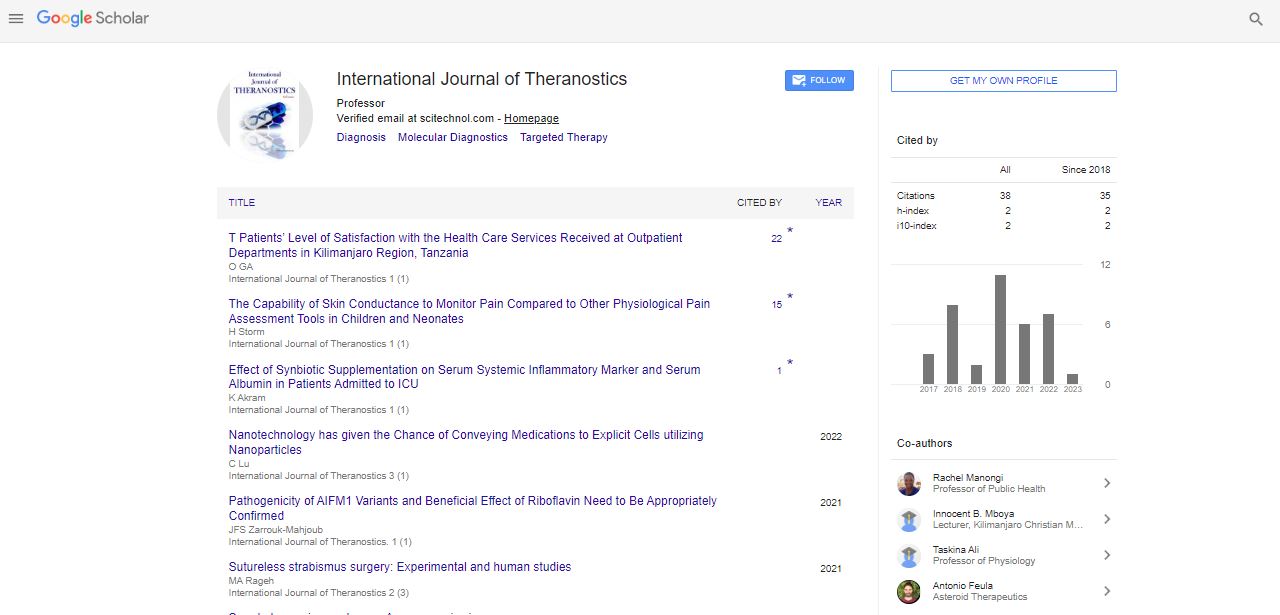Opinion Article, Int J Theranostic Vol: 12 Issue: 2
Advancements in Theranostic Nanomedicine: Exploring its Application
Brandy Sobczak*
1Center for Nanotheranostics, Massachusetts Institute of Technology, Cambridge, USA
*Corresponding Author: Brandy Sobczak,
Center for Nanotheranostics,
Massachusetts Institute of Technology, Cambridge, USA
E-mail: Sobczakrandy77@htomail.com
Received date: 29 May, 2023, Manuscript No. IJT-23-106894;
Editor assigned date: 31 May, 2023, PreQC No. IJT-23-106894 (PQ);
Reviewed date: 14 June, 2023, QCNo IJT-23-106894;
Revised date: 21 June, 2023, Manuscript No. IJT-23-106894 (R);
Published date: 30 June, 2023, DOI: 10.4172/IJT.1000126
Citation: Sobczak B (2023) Advancements in Theranostic Nanomedicine: Exploring its Applications. Int J Theranostic 12: 2.
Description
Theranostic nanomedicine has emerged as a hopefull strategy in modern healthcare, combining diagnostic and therapeutic functionalities within nanoscale platforms. This study discusses recent advances in theranostic nanomedicine, exploring its applications in targeted drug delivery, imaging, and disease monitoring. The challenges and potential solutions for translating nanotheranostics from bench to bedside are also discussed, emphasizing the transformative impact this technology can have on patient care.
Theranostic nanomedicine involves the integration of diagnostic and therapeutic agents into nano-sized delivery systems. These nanoplatforms can improve treatment efficacy by enhancing drug delivery and enabling real-time disease monitoring through imaging modalities.
Therapeutic applications of nanotheranostics
Targeted drug delivery: Nanotheranostics allows for targeted drug delivery, reducing systemic side effects and improving drug bioavailability. Surface functionalization of nanoparticles enables specific targeting of diseased cells, leading to enhanced treatment outcomes in various conditions, including cancer and inflammatory diseases.
Combination therapy: The versatility of nanotheranostics allows for combination therapy, where multiple therapeutic agents can be coloaded into a single nanoparticle. This approach synergizes different treatment modalities, enhancing their collective efficacy and reducing the likelihood of drug resistance.
Imaging applications of nanotheranostics
Contrast agents: Nanotheranostics serves as an excellent platform for contrast agents in various imaging modalities, such as Magnetic Resonance Imaging (MRI), Computerized Tomography (CT), and Positron Emission Tomography (PET). These imaging agents provide valuable diagnostic information, aiding in disease detection, and treatment response assessment.
Image-guided interventions: Real-time imaging capabilities of nanotheranostics facilitate image-guided interventions, allowing for precise and minimally invasive treatments. This is particularly beneficial in oncology, where image-guided therapies can target tumors with high precision.
Disease monitoring with nanotheranostics
Therapeutic response monitoring: Nanotheranostics can monitor the response to treatment, providing early indications of therapeutic efficacy. Clinicians can modify treatment regimens promptly based on the information obtained, tailoring therapy to individual patient needs.
Early detection of disease recurrence: The sensitivity of nanotheranostics in detecting small lesions or residual disease helps in early identification of disease recurrence. This is vital in oncology and other chronic conditions, as early intervention can significantly impact patient outcomes.
Challenges and translation to clinical practice
Biocompatibility and safety: The biocompatibility and safety of nanotheranostic agents are difficult for clinical translation. Rigorous preclinical testing and characterization are essential to ensure the absence of toxicity and immunogenicity.
Scalability and manufacturing: Translating nanotheranostics from the laboratory to the clinic requires scalable and reproducible manufacturing processes. Innovations in nanomaterial synthesis and formulation are necessary to meet the demand for clinical applications.
Regulatory considerations: Navigating regulatory pathways for nanotheranostics can be complex due to their multifunctional nature. Close collaboration between researchers, clinicians, and regulatory agencies is essential to address these challenges effectively.
Future perspectives
The future of nanotheranostics is encouraging, with ongoing research and technology advancements. Targeted drug delivery and imaging capabilities hold the potential to revolutionize patient care across various medical disciplines, ultimately leading to better treatment outcomes and improved quality of life.
Conclusion
Nanotheranostics represents a transformative approach in modern medicine, combining diagnostic and therapeutic functionalities within nanoscale platforms. The integration of targeted drug delivery and imaging capabilities holds great hope for personalized medicine, with the potential to revolutionize patient care in the near future.
 Spanish
Spanish  Chinese
Chinese  Russian
Russian  German
German  French
French  Japanese
Japanese  Portuguese
Portuguese  Hindi
Hindi 